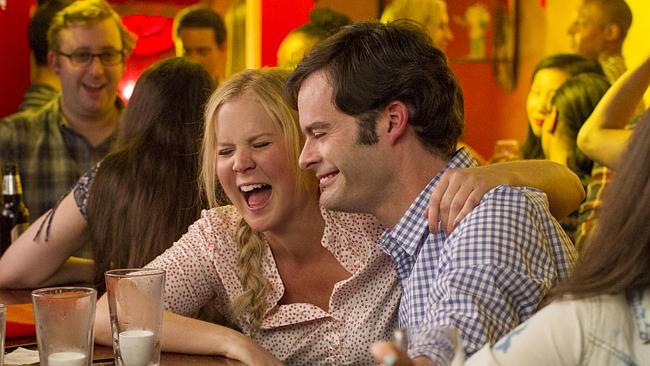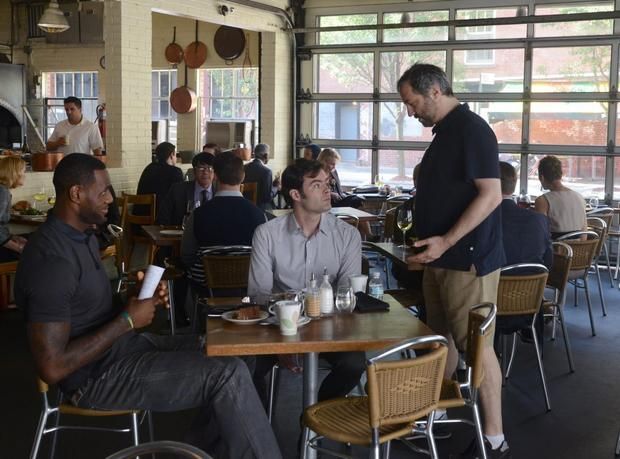How to avoid the “aimless riffing” issue that plagues Apatow’s newest film.
So I went to see Trainwreck last night and, holy shit was it boring! The trailer makes the movie look really good but that’s because the trailer does the one thing the film doesn’t do, which is to FOCUS THE DAMN STORY.
Judd’s biggest issue is his propensity to let scenes drag on for too long. If you saw Trainwreck, chances are, you felt the way I did – which is that the scenes never ended. While a script can survive one or two drawn-out scenes. It can’t survive a bunch of them. And it definitely can’t survive ALL the scenes being that way.
And I understand why Apatow does this. He’s very much a “workshop the scene” kind of guy. He’ll start with the scene as written, then play with it on set, allowing the actors to riff and try a bunch of jokes, the objective being to stuff as much comedy into each scene as possible.
Unfortunately, movies don’t do well with that plan. They like when everything is tight, focused, and to the point. They like when scenes feel like they have a purpose. So in honor of this terrible movie, and Apatow’s lazy approach to scene-writing, it’s time to remind ourselves what the principles of good scene-writing are.
1) Give your featured character an objective in the scene – The key character should have an objective in each scene. This is their “goal.” Play the scene out until the character either achieves or fails at this goal. As soon as one of those two things happens, the scene is over. Notice I said “key” character and not “main” character. That’s because sometimes, someone other than your main character will have the objective in the scene. For example, if your main character gets called into their boss’s office to get fired, it’s the boss’s objective that’s driving the scene (to fire your main character).
2) Get in late, get out early – Good God could Apatow have benefited from this Screenwriting 101 advice. The main reason scenes drag is that you either came into the scene too early or stayed with the scene way too late. Once you know what your key character’s objective in the scene is, try to start the scene as close to that objective as possible (unless you’re trying a specialized dramatic technique – more on that in a sec). So to use our “firing” scene again, get us in that scene right when the boss is about to fire her! Then, once that’s done, cut to the next scene! In Trainwreck, after the boss had fired Amy, we actually STUCK AROUND as two co-workers entered the scene and asked if Amy had been fired yet. It was an attempt to be funny but no one laughed because the objective had already been reached. Whether Apatow knew it or not, he had signified to the viewer that the scene was done. Now had those co-workers walked in and asked this question BEFORE the firing had happened, it might’ve worked (and that actually sounds like it would’ve been funnier). But you can’t do that after all the air has already left the balloon.
a. (Specialized Technique) – Yes, you typically want to come into a scene as late as possible. But there are some instances where a drawn-out scene opening can work. For example, if you utilized some dramatic irony and informed the audience ahead of time that Amy was getting fired (something Amy doesn’t know), now when Amy walks into her boss’s office, you can introduce a few pages of conversation before the firing happens. Why? Because you’ve added the element of anticipation. We know the bomb is going to go off, so there’s an added element of tension to the interaction. So yes, you can ignore the “get in late, leave early” rule (just like you can ignore any rule). But you should have a good reason for doing so.
3) Conflict – This, Apatow knows how to do. He knows that in every scene, there needs to be some sort of conflict driving the scene. Without conflict your characters aren’t trying to work through anything – aren’t trying to come to a conclusion on anything – which leaves the audience wondering why the scene is being included. You could feel conflict in Amy’s scenes with her first boyfriend (John Cena), who liked her more than she liked him, in the scenes with her father, who was always butting heads with Amy about her life, with her sister, who she didn’t see eye-to-eye with on anything, and with the main love interest, who she was afraid to fall for, leading to her sabotaging their interactions. Conflict is good, folks. Use it!
4) Stakes – The higher the stakes are in a scene, the better. If nothing’s on the line, the scene will feel pointless and boring. Obviously, not every scene can be of Level 100 importance. Your main characters can’t be about to break up every single time we’re with them. So you have to stagger the intensity level of the stakes. But there should always be SOMETHING on the line. I recently read an amateur script where two co-workers were kind of hungry so they went to get some pizza. On the way there, the subway train broke down, and we stayed with them for the next four pages as they tried to figure out how they were going to get their pizza. So our two characters weren’t even that hungry. They didn’t have anywhere important to be. They decided to get pizza on a whim. The train broke down, preventing them from getting their food…. Why is this scene supposed to interest us? It doesn’t. Because there’s nothing on the line. You gotta add those stakes, people.
5) Urgency – Urgency is probably the least important of all the scene tips I’m offering today, but don’t underestimate its power. If you put a timer on a scene, you can really add some life to it. Couple it with some high stakes and, baby, you’re cooking with gas. If, for example, in the aforementioned subway scene, we changed it so that our two workers were trying to make it across town for the biggest meeting of their life? If not making it to that meeting meant their company lost a 400 million dollar deal? And they only had 10 minutes left to get there? Now you have a scene that people are going to care about.
6) Necessity – Finally, make sure the scene you’re writing is necessary in the first place. The worst scene is the one that doesn’t need to be in your movie. To know which scenes you need, know what your main character wants in the movie. What’s his goal? In Die Hard, John McClane wants to save his wife from the terrorists. So if you include a scene where John McClane goes swimming in the building’s swimming pool, that scene’s probably not going to play well, is it? That’s because it doesn’t get Johnny closer to saving his wife. Where I see this mistake the most is when the writer doesn’t know what their movie is about in the first place. Since they don’t know what their hero’s after, they can’t plan which scenes are needed to get them there.
Feel free to offer your own scene secrets in the comments section. For example, sometimes you want to “turn” a scene so that it goes in a different direction than the audience thought it would. This is really important in comedy. I was watching Modern Family the other day and uptight married couple Phil and Claire get stuck on a double-date at a nice restaurant with their hillbilly neighbors. You think you know where this is going (the hillbillies are going to cause a scene, being loud and boisterous, embarrassing Phil and Claire), but instead, the hillbillies bust out a nice bottle of wine, have a stellar rapport with the wait staff, and begin bragging about their son being accepted to Julliard.
Don’t just help your fellow writers with these tips, help Judd Apatow. The guy definitely needs to improve his scene work.



